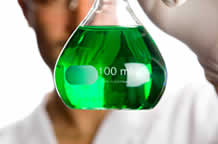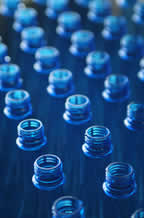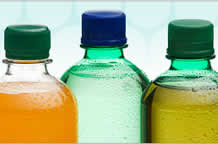
Understanding the chemistry of PET explains why it is globally recognized as safe, and so widely used for food, beverage, pharmaceutical and medical applications
PET is short for polyethylene terephthalate – the chemical name for polyester. PET is made by combining ethylene glycol and terephthalic acid under high temperature and low vacuum pressure to form a polymer chain. The resulting polyester polymer is extremely stable, tough and essentially inert. PET is highly resistant to chemical or biological reaction with other substances. This non-reactive quality is at the heart of PET’s safety.
Although PET bottles are virtually synonymous with convenience-sized soda and water bottles sold in the U.S., many different types of plastics are used for packaging foods and beverage. The names and acronyms for many of these plastics may seem similar, but they have very different properties and chemical structures.
Dispelling Myths and Misconceptions

Many consumers and even some in the media have confused PET with other plastics. This has lead to erroneous assumptions about PET and a host of nonsensical rumors, such as drinking water from a PET bottle that’s been left in a car will cause breast cancer.
To set the record straight, PET does not contain BPA, phthalates, dioxins, lead, cadmium or endocrine disruptors.
In addition, drinking water from a PET bottle that has been left in a hot car, frozen, used more than once, or repeatedly washed and rinsed does not pose any health risk.
PET does not contain BPA. Bisphenol-A (BPA) is a compound used to make polycarbonate, a different type of plastic found in some baby bottles, the lining of metal cans, and reusable sports bottles. PET does not contain BPA and never has.
PET contains no phthalates. Phthalates (i.e., phthalate ester plasticizers or orthophthalates) are not used in PET, nor is PET a phthalate. Plasticizer phthalates are sometimes used to soften other types of plastic, and are believed by some to be potential endocrine disruptors although this is unproven. The confusion seems to come from PET’s chemical name, polyethylene terephthalate. Despite the suffix, PET is not a plasticizer phthalate. Phthalates are low molecular weight monoesters made from ortho-phthalic acid. PET is a high molecular weight polyester made from tere-phthalic acid. They are completely different chemicals.

PET contains no dioxins. Dioxins are a group of compounds sometimes formed with high-temperature combustion (over 750 degrees F.) and certain types of industrial processes involving chlorine. PET does not contain dioxins, nor are dioxins created in the manufacture of PET. Chlorine is required for the formation of dioxins, and PET contains no chlorine. In short, PET contains no dioxins and dioxins can’t be produced when a PET container is heated, microwaved or frozen (common urban myths).
PET contains no endocrine disruptors. PET contains no known endocrine disruptor chemicals, and there is no credible scientific data to suggest that PET produces estrogen or endocrine modulating activity. Research studies have exposed both male and female laboratory animals to terephthalates during all phases of the reproductive cycle and found no reproductive effects in either the test animals or their offspring.
PET contains no lead or cadmium. From time to time, e-mail chain letters have circulated with allegations that PET bottles leach lead or cadmium. These rumors are untrue. PET does not contain lead or cadmium, and neither one is used in the manufacture of PET.
About Antimony

Very small amounts of antimony compounds are used in the production of PET as well as glass. Antimony oxide (not the metal itself) is typically used as the catalyst in making PET, which is chemically bound into the polymer at very low levels of 200 -300 parts per million.
Over time and with extended exposure to a hot environment, trace amounts of antimony may migrate into water or beverages bottled in PET. Health agencies around the world have confirmed these very small amounts – averaging less than 1 part per billion – pose no health concerns.
Numerous studies have been conducted on antimony levels in PET-bottled water under the most extreme and adverse test conditions. No study has ever found toxic amounts of antimony in water bottled in PET.
About Aldehydes
Trace amounts of acetaldehyde, and to a lesser extent other aldehydes, are unavoidable byproducts in the production of PET bottles. Modern manufacturing practices in the PET industry are used to minimize the formation of aldehydes.

Acetaldehyde is a naturally occurring substance found in many foods, especially ripe fruits, including apples, grapes and citrus fruits. It is also a natural constituent of butter, olives, frozen vegetables and cheese, and is formed in the body when certain foods are digested.
The insignificant amounts of aldehydes that may be found in PET or PET-packaged items are far lower than the typical levels found in many of these foods or in the human body, and pose no health risk.
The chief concern over trace amounts of acetaldehyde in PET-bottled beverages is literally one of taste. A few individuals with very highly developed olfactory senses can sometimes detect its faintly fruity taste in bottled water. (The taste is too faint to be detected in anything flavored.) PET bottlers sometimes use highly-trained taste specialists to ensure that any possible aldehyde taste is avoided.
